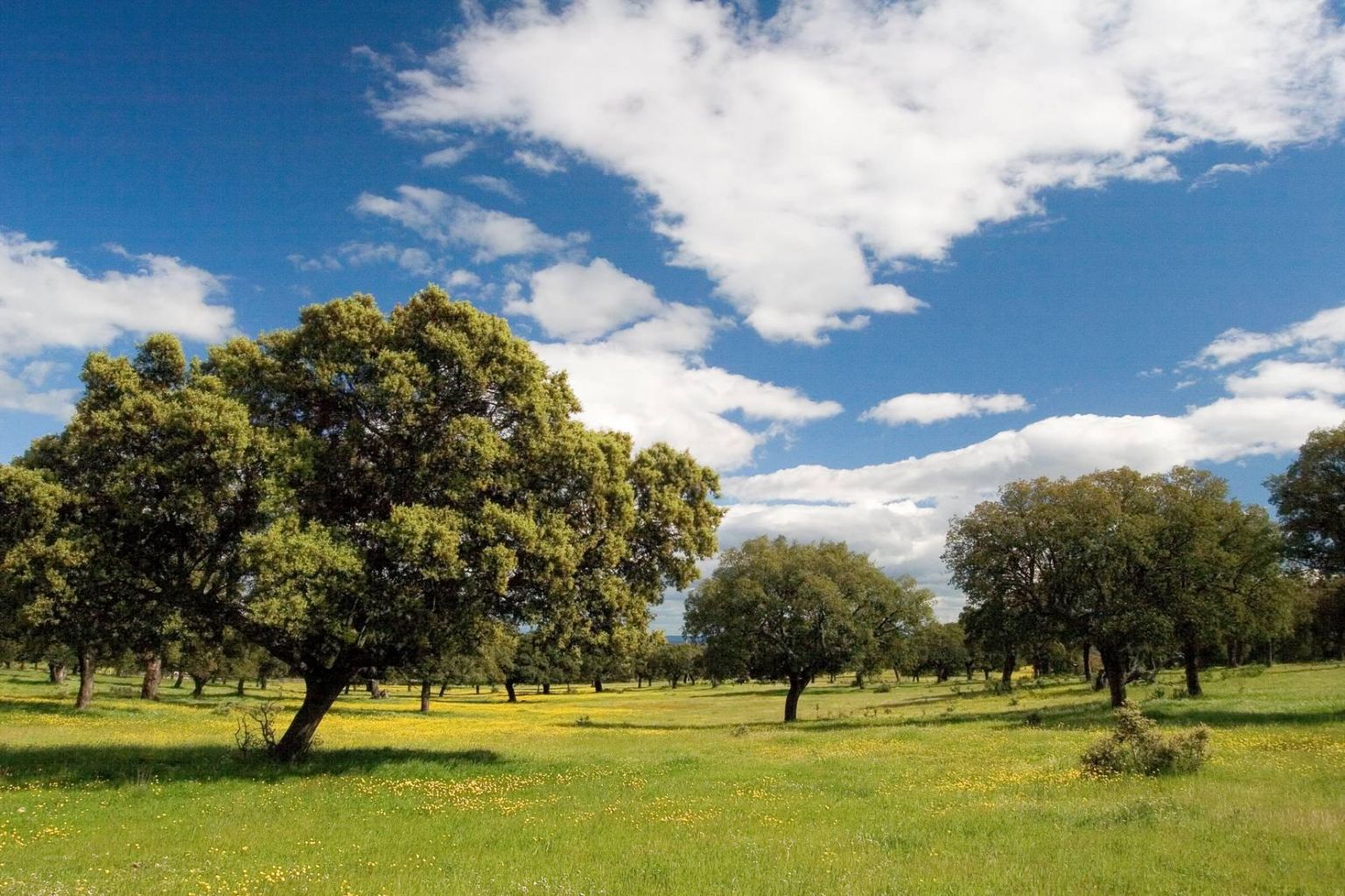
Dehesa Farmen in Spanien
Beschreibung des Systems
Dehesa ist ein agrosilvopastorales system, wo Bäume, einheimische Gräser, Kulturpflanzen und Vieh unter Bewirtschaftung positiv zusammenspielen. Sie entsteht bei kontrollierter Rodung von immergrünen, mediterranen Waldgebieten sowie Buschländer, bei der die Vereinfachung in Struktur und Artenvielfalt im Vordergrund stehen. Typischerweise wird der Baumbestand reduziert, die Verbuschung eliminiert und die Bildung von Grass durch Weidenvieh und Kulturpflanzen gefördert. Zudem gehören traditionelles Vieh in kleiner Anzahl und vorsichtige Nutzung von Steineichen zu den Charaktereigenschaften der Dehesa. In Spanien zählen heute 2.3 Millionen Hektaren zu diesem Landtyp. Auch in Portugal, wo sie „mantados“ genannt werde, wird eine Fläche von 0.7 Millionen Hektaren gepflegt. Dehesas gehören zu den am besten erhaltenen extensiven Landwirtschaften in Europa. Durch die Integration und der traditionellen Landnutzung wird die Erhaltung der Biodiversität als beispielhafte Landnutzung angesehen.
Erste Stakeholder Treffen
Das erste Stakeholder (Interessengruppe) Treffen wurde am 30. Mai 2014 an der Waldschule der Universität Extremadura in Plasencia gehalten. Der Event war sehr erfolgreich und wurde von mehr als 90 Interessenten besucht. Unter den Teilnehmer waren Bauern, Züchter, Förster, Landbesitzer, Repräsentanten von regionalen und nationalen Verbänden, Landwirtschaftsunternehmen, (extension services), Naturbezogene NGOs, lokalen Aktionsgemeinschaften und politische Entscheidungsträger. Eine umfassende Wahrnehmungsanalyse der positiven und negativen Aspekte des Dehesa Landwirtschaftstyps und potentielle Innovationen für die Forschung wurden durchgeführt. Methoden der Baumregeneration, Futtermittel, Grasland und die Möglichkeit einer Dehesa-Marke wurden als potentielle Bereiche für die Forschung identifiziert.
Falls Sie mehr über die Aktivitäten dieser Gruppe wissen möchten, kontaktieren Sie bitte Dr. Gerardo Moreno von der Universität Extremadura.
Laden Sie den ersten Bericht der Interessengruppe runter
Laden Sie den ersten Forschungs- und Entwicklungsbericht runter
Laden Sie die Systembeschreibung runter
Ein Forschungsupdate der Dehesas in Spanien wurde im Dezember 2015 veröffentlicht.
Lessons learnt
Gerardo Moreno and colleagues at the University of Extremadura have written a comprehensive and informative report on the various innovations tested within the Dehesa stakeholder group in Spain.
The first part of the report focus on the search of alternative low cost shelters and practices for the regeneration of the trees of the dehesa. Some of the main lessons learnt are:
- Tree regeneration in the dehesa needs to be an integrated part of regular management practice; a rotational stage of grazing exclusion could be included in long-term farm management plans.
- Assisted regeneration can be based either on seeding acorns or on planting nursery-grown seedlings. Both approaches require seed and/or seedling protection.
- Application of cat/dog excrement around sown acorns can be recommended for small scale reforestation. CHANGE around young plants BY acorns sown
- Thorny wire-mesh tree guards proved to be an efficient, long-lasting solution and cheaper form of tree protection than classic wire mesh tree guards.
The second part of the report focuses on the option to improve fodder self-sufficiency by using protein-rich fodder crops and self-seeding pastures. Some of the main lessons learnt are:
- Three varieties of triticale are recommended; the trees can increase winter forage yields and the quality of the forage. The triticale can be grazed by livestock in the winter before the start of stem elongation.
- The sowing of legume-rich self-reseeding pasture can increase pasture productivity and quality for at least a decade. Grazing needs to be delayed in the initial years to ensure good establishment.
- The increase in the soil nitrogen, due to the legumes, also increases the protein content of other pasture species.
- The sowing of pasture increased the soil content of carbon accumulated. Although it reduced slightly the α diversity of plants, the total species richness (ϒ diversity) was unaltered.
- Farmers in the study reported that the improvement in the pasture quality and productivity offset the costs of the seed mixture and fertilizers.
The third part of the report focused on consumer acceptance for dehesa products and services. Some of the lessons learnt are:
- Consumers were more familiar with the term "dehesa" than "agroforestry"
- Consumers associated the dehesa with high-quality livestock products and a landscape of high cultural value.
- Possible dehesa products with development potential include asparagus, fungi and mushrooms, acorn-based foods, medicinal plants and cosmetics, herbs and herbal tea. CHANGE acorn beer BY acorn-based foods
Lastly the report highlights that more research is still needed on the use of new technologies (such as GPS collars) to improve dehesa management and the use of fast-intensive rotational management. Preliminary results also indicate that (ignoring the methane produced by livestock), a positive annual carbon balance of the dehesa of Majadas of about 0.5 t C/ha.